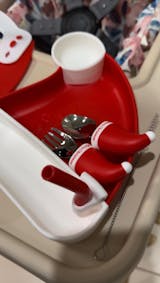Introduction
When it comes to your baby’s health, every choice matters — including what they eat from. Many parents wonder: Should I use silicone or plastic feeding products? In this blog, we’ll compare silicone and plastic, highlight the pros and cons, and help you choose the safest option for your little one’s mealtime.

Why Safety Matters in Baby Feeding Products
Babies explore the world through taste, and their developing bodies are more sensitive to chemicals and toxins. That’s why the material you choose for plates, spoons, and cups is just as important as the food you serve.

Plastic Feeding Products: The Pros and Cons
✅ Pros:
- Lightweight and affordable
- Wide variety of designs and colors
- Easy to find in most stores
❌ Cons:
- May contain harmful chemicals like BPA, phthalates, or microplastics
- Can degrade over time, especially when microwaved or washed in hot water
- Less durable — scratches easily and may harbor bacteria
Silicone Feeding Products: The Pros and Cons
✅ Pros:
- Made from food-grade, BPA-free silicone (safe and non-toxic)
- Heat-resistant: safe for sterilizers, dishwashers, and microwaves
- Soft and flexible — gentle on gums and perfect for teething babies
- Durable and long-lasting, won’t crack or break
- Eco-friendly alternative to single-use plastics
❌ Cons:
- Slightly more expensive upfront than plastic
- Needs proper cleaning to avoid lingering food stains
Silicone vs. Plastic: The Clear Winner
When weighing long-term safety and durability, silicone is the better choice for baby mealtime. It’s non-toxic, safer for repeated use, and gentle for growing babies who are learning to self-feed. While plastic may seem convenient, the potential risks often outweigh the benefits.


